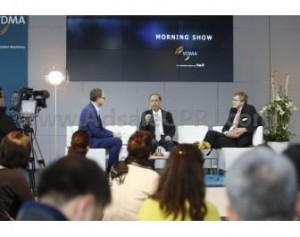China has been no longer a low wage-cost country for a long time now. Its rapid climb to become the second largest national economy in the world goes together with strong growth in wage costs.
This cost pressure drives companies to use more automation and new technologies in production – exactly the path “Made in China 2025” strategy has drawn out.
Industry 4.0 is still not a technology trend in China. “China continues to be a developing country. The prerequisites for Industry 4.0 do not exist yet,” admitted Stanley Chu, Chairman of Adsale Exhibition Services Ltd, the CHINAPLAS organizer.

Speaking at the TV Pavilion during K 2016, he said there are only a few individual companies that already apply networked production today.
Industry 4.0 is still a vision for Chinese companies, but it is one that will have to become reality in the foreseeable future to counter the cost pressure. Chu therefore wants, with support from VDMA, to place the subject of Industry 4.0 in the foreground at CHINAPLAS next year.
Interest in Industry 4.0 is high, at least with Chinese visitors to the K 2016 trade fair. The number of exhibitors is also large, with more than 200 companies participating at the K Show this year. “The Chinese exhibitors are very important for the K,” said Erhard Wienkamp, Divisional Executive Director at Messe Düsseldorf.
“A technical development upwards is very clearly recognizable,” said Gero Willmeroth, Sales and Service President at the subsidiary Engel Machinery Shanghai.
Companies in China not only need to compensate the cost pressure however. They are increasingly pressurized by their customers to produce at their high-tech level.
“Everything at Chinese companies revolves around efficiency. We have to offer solutions that help Chinese customers to become more efficient,” said Dr. Reinhard Schiffers, Head of Machine Technology in the KraussMaffei Group. Industry 4.0 will therefore be seen as the path to reach this aim.
There are still a number of hindrances preventing entry into digitalization and networking on a large scale. One of them lies in the technical infrastructure. “There are still significant restrictions. Fast Internet is seldom. Also the reliability of Internet is in many cases entirely insufficient,” observed Willmeroth.
On top of that well trained professional staff is lacking everywhere. “It is a very large challenge to get talented people. The schools still do not bring forward enough young people who can be used in the companies,” said Uwe Thönniss, a former CEO of Brückner Group‘s Servtec subsidiary.
In addition to that, there is only a very weakly pronounced understanding of data security.
Nevertheless, there is no way for German companies to avoid maintaining their own production in China and, at least in future, to also set up a part of research & development locally.
Initially, product development is adapted to Chinese requirements, later through development of own products for the Chinese market. “We will see a larger part of the value creation chain in China in the future,” Willmeroth said.

















